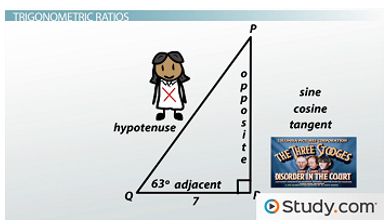Practice Finding the Trigonometric Ratios
So you know what sine, cosine and tangent are. Great! But how do you use them? Find out how in this lesson as we find missing sides and angles using trigonometric ratios.
Trigonometric Ratios
Meet X. X is suffering from amnesia. X isn't even her real name. All she knows is she's on this right triangle.

Can we help X find out her identity? Let's see. Can we use the Pythagorean theorem? Well, we can use that to find the missing side of a right triangle, but we need to know the other two sides. We only know that QR is 7. And let's just say 7 isn't very friendly. There's a rumor that 7 ate 9, which worries X.
What about angle Q? We know that's 63 degrees. Is that useful? It is, but only if we know how to use trigonometric ratios. The trigonometric ratios we're going to focus on here are sine, cosine and tangent. These are like the Moe, Larry, and Curly of trigonometry. Sure, there are other Stooges, but these are the best.
Let's define them. To start, let's label the sides of this triangle. X is on PQ, the longest side and the side opposite the right angle. We call that the hypotenuse. If we're talking in terms of angle Q, then QR is called the adjacent side. PR is the opposite side. They're adjacent and opposite to the angle in question.
Note that the hypotenuse is always the same, but if we were focusing on a different angle, the other labels would change. For example, if we knew angle P, then PR would be the adjacent side and QR would be the opposite side. Ok, fear not, X, we're almost there.

Let's get to our ratios. First, sine is opposite/hypotenuse, which we write as sin? = opposite/hypotenuse. We're going to use ? to stand in for the angle. Next, cosine is adjacent/hypotenuse. We write this as cos? = adjacent/hypotenuse. Finally, tangent is opposite/adjacent, which we write as tan? = opposite/adjacent. We can remember these with the acronym SOH CAH TOA.
Solving for a Side
So how do we use this? You'll usually be asked to find a missing side or angle in a right triangle by using these trigonometric ratios. With X, we're missing a side length. Which side? The hypotenuse. Okay, which of our trig functions uses the hypotenuse? SOH CAH TOA. SOH and CAH have that H, so sine or cosine is what we need.
What else do we know? We know QR, which is adjacent to the angle we know. Sine or cosine - which uses the adjacent? CAH, that's cosine. Cosine is adjacent over hypotenuse. So we can set up our equation like this: cos(63) = 7/x.
X is a little nervous about being so close to 7, but thankful that she's almost figured out her identity. Okay, what's the cosine of 63? If we use our calculator, we find out that cosine of 63 is .454. Remember to be sure your calculator is set to degrees, not radians.
So .454 = 7/x. Let's cross multiply to get .454x = 7. Then divide both sides by .454 to get x = 15.4, so that's what xis! 15.4. We did it. X is a mystery no longer.
Practice Problem
Sometimes, these problems aren't as easily formatted. Here's what they might look like: In triangle DEF, hypotenuse DE = 12, and angle D = 38 degrees. Find the length of EF, to the nearest tenth.
Well, the first thing we should do is bust out our art skills and draw this triangle. You can put your protractor away; it doesn't need to be exact. This will do.